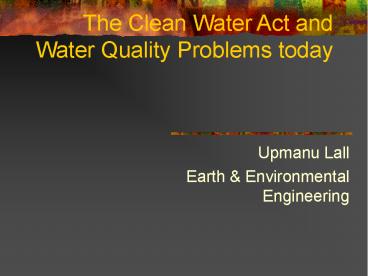The Clean Water Act and Water Quality Problems today PowerPoint PPT Presentation
Title: The Clean Water Act and Water Quality Problems today
1
The Clean Water Act and Water Quality Problems
today
- Upmanu Lall
- Earth Environmental Engineering
2
Water Quality the major foci
- Chemical, Physical and Biological Attributes of
Water Bodies (Rivers, Lakes) - Human Exposure, Endangered Species or other
Biota, Fisheries - Chemical and Biological Constituents of Drinking
Water - Human Health
3
/
4
(No Transcript)
5
(No Transcript)
6
Non-Point Source Pollution is now the major
concern
7
(No Transcript)
8
Key Legislation mandating EPAs role in Water
National Environmental Policy Act, 1969
Environmental Assessments (EA's) and
Environmental Impact Statements (EIS's) for all
federal activities Federal Water Pollution
Control Act 1972 Regulates discharges of
pollutants to waters Endangered Species Act,
1973 Conservation of threatened/endangered
plants and animals and the habitats in which they
are found The Safe Drinking Water Act, 1974,
1996 Protect the quality of all waters actually
or potentially designed for drinking use, whether
from above ground or underground sources. EPA to
establish safe standards of purity and required
all public water systems to comply with primary
(health) standards. State governments, also
encourage attainment of secondary standards
(nuisance). The Clean Water Act 1977 Focus on
toxics. EPA gets authority to set effluent
standards on an industry basis (technology-based)
and water quality standards for all contaminants
in surface waters. The CWA makes it unlawful for
any person to discharge any pollutant from a
point source into navigable waters unless a
permit (NPDES) is obtained. Comprehensive
Environmental Response, Compensation, and
Liability Act, 1980 Federal Superfund to clean
up uncontrolled or abandoned hazardous-waste
sites as well as accidents, spills, and other
emergency releases of pollutants and contaminants
into the environment The Clean Water Act 1987
authorized citizen suit provisions, and funded
sewage treatment plants (POTW's) under the
Construction Grants Program. EPA can delegate
many permitting, administrative, and enforcement
aspects of the law to state governments.
Resource Conservation Recovery Act, 1976,
1986 Underground Storage Tanks, Non-Haz Waste
9
The Clean Water Act of 1977 amends the Federal
Water Pollution Control Act of 1972, to set a
basic structure for regulating discharges of
pollutants to waters of the United States. The
law gave EPA the authority to set effluent
standards on an industry basis (technology-based)
and continued the requirements to set water
quality standards for all contaminants in surface
waters. The CWA makes it unlawful for any person
to discharge any pollutant from a point source
into navigable waters unless a permit (NPDES) is
obtained under the Act. The 1977 amendments
focused on toxic pollutants. In 1987, the CWA was
reauthorized and again focused on toxic
substances, authorized citizen suit provisions,
and funded sewage treatment plants (POTW's) under
the Construction Grants Program.
10
Assessed Rivers, Lakes, and Estuaries Meeting All
Designated Uses 1994/1996 Using Latest State
Information Reported - EPA
11
Percent of Impaired Waters - 1998
-EPA
12
-EPA
Sediments Nutrients Pathogens Dissolved
Oxygen Metals Habitat pH Suspended
Solids Temperature Flow Alterations Pesticides Nox
ious Plants Turbidity Fish Contamination Ammonia
18
0
of Water Segments
13
Sediment Runoff Potential - 1990-1995
Nitrogen Runoff Potential - 1990 -1995
Pesticide Runoff Potential - 1990 -1995
Fish Consumption Advisories - 1997
14
N and P occurrence by land use
USGS
15
The Otter Tail River, Minnesota which supports a
healthy growth of wild rice, and Fir Creek,
Oregon which contributes to Portland's
drinking-water supply, are examples of streams
with low nutrient concentrations
16
Effluent can make up a substantial part of the
streamflow in some areas. For example, wastewater
treatment plants annually contribute about 69
percent (and at times 100 percent) of the flow in
the South Platte River downstream from Denver,
Colorado. About 1,200 tons of phosphorus enter
the South Platte River Basin every year from
wastewater treatment plants.
17
Pesticides
18
ORGANOCHLORINE PESTICIDE TRENDS IN SEDIMENT CORES
FROM WHITE ROCK LAKE IN DALLAS, TEXAS, 1996
19
(No Transcript)
20
National Primary Drinking Water Regulations
21
(No Transcript)
22
(No Transcript)
23
Summary
- The Clean Water Act has succeeded in regulating
point sources of pollution - Non-point source pollution is a major challenge
since the sources are diffuse and varied (include
atmospheric deposition) and chemicals of concern
often degrade into a series of byproducts - Land use and climate play a large role as sources
and also in determining impacts - Drinking water treatment technology is largely
mature. However, improvements in reverse osmosis
and desalination are opening a new chapter

